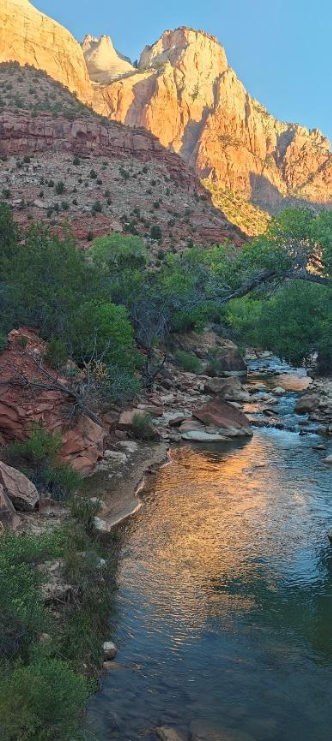All Souls, Year B: Nonhuman Saints and Holy Ones
Wes Howard-Brook and Sue Ferguson Johnson
As we move toward the celebration of All Saints, we explore in this week’s readings the themes of “holy ones” present throughout creation, with a focus on the nonhuman realm, particularly mountains as found in the Isaiah reading, “new creation” as part of the ongoing evolutionary process from the Revelation reading and the unbound earthly-body resurrection we see in the Lazarus story in John’s gospel. We treat the reading from Wisdom briefly as it doesn’t directly link with the theme.
Commentary
Wisdom of Solomon 3.1-9
The RSV renders 3.1 as “But the souls of the righteous are in the hand of God, and no torment will ever touch them.” However, the Greek word translated “soul” is psuchē, referring in the Hebrew Scriptures to the “life” that the Creator puts in all beings. It translated Hebrew nefesh, used in Genesis 1.20, 21 and 24 to refer to the life of nonhumans, and in 1.30 for the ‘adam, the “earthling.” Thus, it is the lives of the righteous that are in the hand of God.
In 3.4, we hear that for the righteous, “their hope is full of immortality [Greek, athanasia]. The word for “immortality” is a rare one, but Paul uses it in 1 Corinthians 15.53-54 for the state of those who have put on the “imperishable” body of resurrection. The “earthy” nature of the promise is underscored by the prediction in 3.8 that the godly “will govern nations and rule over peoples”. We here, then, that the hope found in the Wisdom reading is not necessarily for a “soul” to be rewarded in “heaven,” but for a risen body to experience restoration here and now.
Isaiah 25.6-9
“On this mountain…”
photo of cross-section of more than a billion years of the Grand Canyon
The Bible has at its heart a history of holy mountains: Sinai/Horeb, Zion, the mountain of Transfiguration. Mountains are mentioned over three hundred times in the Bible! Certainly Isaiah has Zion, the mountain on which Jerusalem and the Temple stood, in mind. Yet he doesn’t speak of the city or building, but of the structure only the Creator could build.
We took our annual “September sabbatical” this year as a road trip tour of national parks running down the middle Rockies: Glacier, Yellowstone, Grand Tetons, Arches, Bryce Canyon, Zion (!), and Grand Canyon. The mountains spoke to us, not just of their incredible beauty and grandeur, but of their unimaginable age. While our biblical ancestors had no idea just how old some rocks are, they certainly knew that the mountains were older than humanity. We hear this reading inviting us to see these Ancient Ones as holy ancestors, well-worthy of veneration as “saints, those who “enflesh” the empowering glory of the Creator.
photo of Parus River in Zion National Park
Isaiah speaks of the “shroud that is cast over all peoples” and “over all nations” as being “on this mountain.” That is to say that what we call the “religion of empire” (see “Come Out, My People!:” God’s Call Out of Empire In the Bible and Beyond [Orbis, 2010]) prevailed in a “disinformation campaign” to persuade people that YHWH was under the control of the temple elite. But for the prophet and for his hearers, the shroud is destroyed and the “veil” is lifted, to reveal the Creator reigning over all creation. Just outside the frame of our passage in 25.10 we hear, “the hand of YHWH will rest on this mountain.” The people are to look to the mountains to discover where the real power lies!
This mountain—Mount Zion—is a holy mountain, shining forth to reveal the power and grace of the Creator. And today, at Zion National Park and similar places, we can also revel in the Creator’s majestic grandeur.
Revelation 21.1-6a
“And I saw a new heaven and a new earth; for the first heaven and the first earth had passed away, and the sea was no more.” (21.1)
Looking up from the Bright Angel Trail, Grand Canyon
Many earth-focused folk struggle with this image of one creation seeming to replace another. But our September travels gave us a new perspective on this passage: the “new earth” names the ongoing reality of God’s living presence shaping and moulding the planet in the ongoing process of creation.
At Grand Canyon, we look out across harsh desert in the deep divide carved by the Colorado River. And yet, descriptive plaques inform us that this land was once a tropical ocean and that alligators swam in the Arctic! Perhaps we who so love Mother Earth are a bit like the disciples on the mountain of Transfiguration: we want to “freeze frame” the moment so we will always be able to see and enjoy the earthly elements with which we grew up. But the ancient, holy mountains put us in our places: what seems so still and “permanent” is in constant transformation, but at a speed we cannot begin to comprehend. Each and every moment, earth collaborates with the Creator in the process of “new creation.” Can their witness inspire us to do the same?
As in a grand cathedral, we stand amid such Saints in awe and silence. Perhaps in place of more words, these images might provide inspiration for experiencing our earthy ancestors as among the “holy ones.”
Moon over mountain at Zion National Park
Red “hoodoos” in Bryce Canyon
Sue among the hoodoos at Bryce
John 11.32-44
The prologue of JG “sets the stage” for an earthed reading of the gospel, with it’s echoes of the Genesis creation story:” In the beginning…(Word, Light, Life, made flesh and dwells among us).” The Lazarus story in John 11 is one of the gospel’s many portrayals of the how empire’s “deforming” words obscure the elemental powerful Presence of the One revealed throughout creation. The chapter is a multi-layered rich portrayal of understandings and responses to death, leading into today's passage.
Here we see Jesus weeping, in deep anguish and frustration, when those he loves don’t understand that the creating/re-creating Word is made flesh throughout the material world here and now. Right before today’s lectionary passage, we hear Martha’s earnest proclamation of faith. “I know that he will rise again in the resurrection on the last day.” and she identifies Jesus as “Son of God.” Her words echo the theology many of our churches emphasize and we may espouse, if we have not yet apprehended the reality embodied in the elemental I AM revealed in this gospel. Martha understands the “afterlife” dimension of Life. But her proclamation falls short of what created earth (including humans) can move into and through: death-to life resurrection here and now. Jesus’s calls “Come out!” to his beloved friend, Lazarus, who is portrayed as an iconic manifestation of an earthly resurrection Life, coming out of the black cave of empire’s darkness and fear. We later see the raised Lazarus at the “communion table” (12.1-8) where Mary models the freeing beauty of the physical Presence known throughout creation, moving her. Mary’s extravagant love and physical response to Jesus represent the “inspired earth” Genesis portrays as who we are created to be. The earth-creating Word shines the Light on the embodied Way gloriously radiating through the lives of the inspired saints we remember and honor and celebrate: All creation—nonhuman and human—is Inspired Earth. May we live into the bedrock communion of Life we are created to experience on this holy ground.
Grand Tetons
Preaching and Teaching Ideas
On This Mountain
In this season, we celebrate the “thin places,” where we are invited to see and move through the sometimes very-thin veil between dark and light, life and death. Which “bedrock reality” is the foundation of our hope and our elemental source of wisdom? Is it the human-constructed “temple mount” of churches that are built on conventional wisdom of empire’s “cover story “ or is it the liberating wildness and intimate communion found in immersion in re-wilding creation?
New Heaven and New Earth
How do we hold and honor our convicted prophetic stance and eco-justice action, as we behold the deeper and larger picture of the Creator’s ever-evolving earth? How might this lead to our conscious, prayerful participation on our own evolutionary process, as individuals and as a species, leading, as Pierre Teilhard de Chardin proclaimed, to widespread Christ-consciousness?
Come Out!
We approach All Saints this year in the midst of a deeply-troubling time on a tortured earth. It’s certainly understandable that the darkness and death that permeates our world often leads us to anxiety and fear. In the earlier parts of the Lazarus story (immediately preceding today’s passage) we see a number of our common responses to impending death: prayers of “magic prevention,” bravado, frantic activity, focus on traditional obligations, reliance on other-world theology. In contrast, we see Mary’s embodied presence/Presence connecting and pouring out the denoted Love that moves us into the empowering Light of resurrection here and now.
As I (Sue) have moved into my 70’s (!), I’m experiencing a renewed longing to remain open to the ongoing Presence of those who have gone before us. In the Mystery of all things, the visceral experience of our “access” to the realm of resurrection continues to become more vivid and palpable through the prayerful practices of attentiveness to the “thin places,” sacred re-membering of beloved ones in the Light of Now, and immersion in creation. Our invitation is both to celebrate and to enter into the communion of saints, human and otherwise.
Sources and Resources
“Visionary John Wesley Powell Had a Plan for Developing the West, But Nobody Listened”, https://www.smithsonianmag.com/smithsonian-institution/visionary-john-wesley-powell-had-plan-developing-west-nobody-listened-180969182/. Brief story of one of the first and greatest ecopioneers, and his vision for mountains, deserts, waters and living beings thriving together in harmonic balance.
Edward Abbey, Desert Solitaire (1968): Musings and stories from the legendary ecowarrior during his year in Arches National Park in the 1950s. Deeply spiritual in a nontraditional way, offering many insights and prophetic warnings about the need to preserve such sacred spaces.
“Unveiling the Spiritual Meaning of Mountains: A Journey to Inner Peace and Enlightenment,” https://tucsonspiritualdirection.org/spiritual-meaning/mountain. A simple but effective overview of the power of mountains to penetrate and shape our hearts and lives.
“The Mountain and the Goddess by Judith Shaw,” https://feminismandreligion.com/2020/03/25/the-mountain-and-the-goddess-by-judith-shaw/. Feminist and cross-tradition reflections on sacred female imagery of mountains and the formations of peoples.
Contributor Bios
Wes Howard-Brook and Sue Ferguson Johnson share the ministry, Abide in Me (John 15), seeking to interweave the mystical and prophetic, the personal and the political, the human and the nonhuman in the name of Jesus https://www.abideinme.net/ . Wes and Sue have been teaching and writing on the Bible for nearly 40 years. Sue is a spiritual director for individuals and groups. Wes, after 20 years teaching at Seattle University, retired in 2021 to create the “Radical Bible” YouTube channel, a free, word-by-word, video commentary on the Bible (https://www.youtube.com/@radicalbible). They dwell in the Issaquah Creek Watershed, traditional and unceded land of the Issaquah Band of the Snoqualmie people. They are blessed to have three of their five adult children and three of their four grandchildren in the same watershed.







